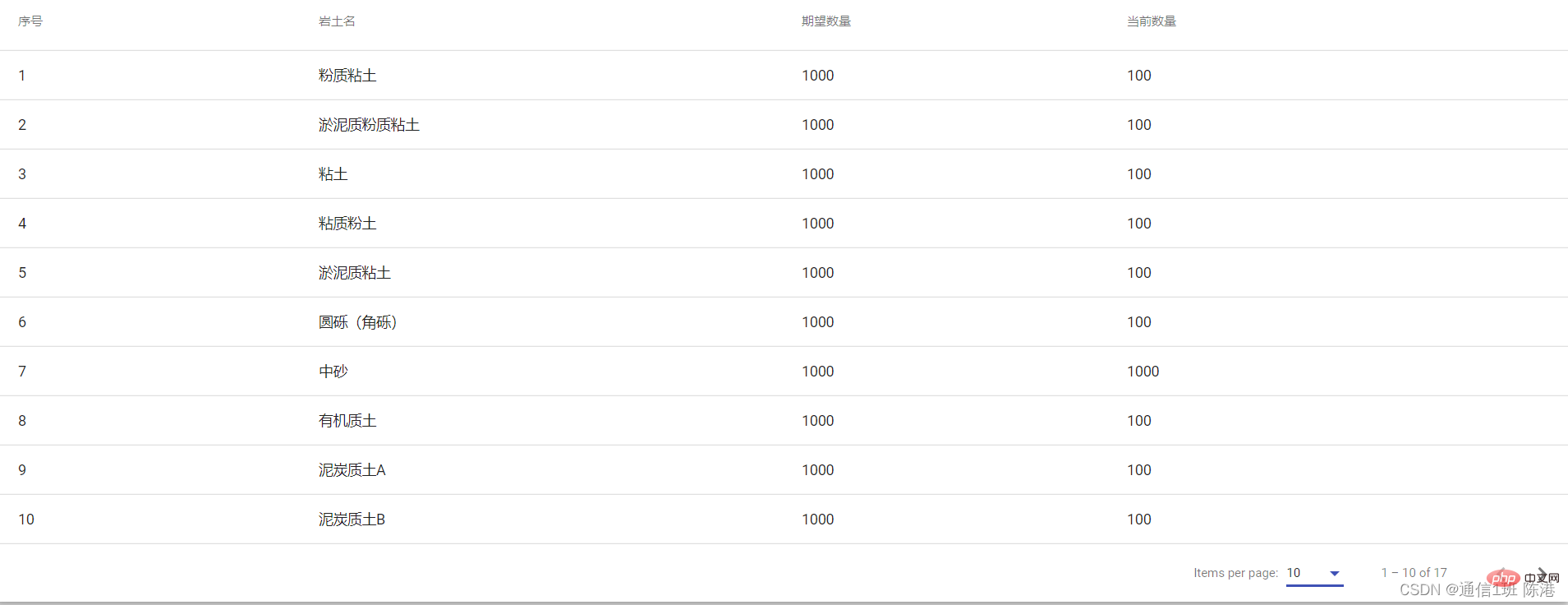 Web Front-end
Web Front-end
 JS Tutorial
JS Tutorial
 Let's talk about how to use angular Material to make statistical tables
Let's talk about how to use angular Material to make statistical tables
Let's talk about how to use angular Material to make statistical tables
How to use angular Material to make statistical tables? The following article will introduce to you how to use angular Material to make statistical tables. I hope it will be helpful to you!

Use angular Material to make statistical tables
Install Angular Material, component development tool (CDK) and Angular animation library, and running the code schematic
ng add @angular/material
The table schematic will create a component that renders an Angular Material pre-built with sortable, pagable data sources. [Recommended related tutorials: "angular tutorial"]
ng generate @angular/material:table texe1
Then make modifications based on this.
The html file of this component
<div class="mat-elevation-z8">
<table mat-table class="full-width-table" matSort aria-label="Elements">
<!-- Id Column -->
<ng-container matColumnDef="id">
<th mat-header-cell *matHeaderCellDef mat-sort-header>序号</th>
<td mat-cell *matCellDef="let row">{{row.id}}</td>
</ng-container>
<!-- Name Column -->
<ng-container matColumnDef="name">
<th mat-header-cell *matHeaderCellDef mat-sort-header> 岩土名</th>
<td mat-cell *matCellDef="let row">{{row.name}}</td>
</ng-container>
<!-- num1 Column -->
<ng-container matColumnDef="num1">
<th mat-header-cell *matHeaderCellDef mat-sort-header> 期望数量</th>
<td mat-cell *matCellDef="let row">{{row.num1}}</td>
</ng-container>
<!-- num2 Column -->
<ng-container matColumnDef="num2">
<th mat-header-cell *matHeaderCellDef mat-sort-header> 当前数量</th>
<td mat-cell *matCellDef="let row">{{row.num2}}</td>
</ng-container>
<tr mat-header-row *matHeaderRowDef="displayedColumns"></tr>
<tr mat-row *matRowDef="let row; columns: displayedColumns;"></tr>
</table>
<!-- 控制表格数据的显示长度 -->
<mat-paginator #paginator
[length]="dataSource?.data?.length"
[pageIndex]="0"
[pageSize]="10"
[pageSizeOptions]="[5, 10, 17]"
aria-label="Select page">
</mat-paginator>
</div>The texe1-datasource.ts file of this component
import { DataSource } from '@angular/cdk/collections';
import { MatPaginator } from '@angular/material/paginator';
import { MatSort } from '@angular/material/sort';
import { map } from 'rxjs/operators';
import { Observable, of as observableOf, merge } from 'rxjs';
// TODO: Replace this with your own data model type
export interface Texe1Item {
name: string;
id: number;
num1: number;
num2: number;
}
// TODO: replace this with real data from your application
const EXAMPLE_DATA: Texe1Item[] = [
{id: 1, name: '粉质粘土', num1:1000, num2:100,},
{id: 2, name: '淤泥质粉质粘土', num1:1000, num2:100,},
{id: 3, name: '粘土', num1:1000, num2:100,},
{id: 4, name: '粘质粉土', num1:1000, num2:100,},
{id: 5, name: '淤泥质粘土', num1:1000, num2:100,},
{id: 6, name: '圆砾(角砾)', num1:1000, num2:100,},
{id: 7, name: '中砂', num1:1000, num2:1000,},
{id: 8, name: '有机质土', num1:1000, num2:100,},
{id: 9, name: '泥炭质土A', num1:1000, num2:100,},
{id: 10, name: '泥炭质土B', num1:1000, num2:100,},
{id: 11, name: '砂质粉土', num1:1000, num2:100,},
{id: 12, name: '粉砂', num1:1000, num2:100,},
{id: 13, name: '细砂', num1:1000, num2:100,},
{id: 14, name: '粗砂', num1:1000, num2:100,},
{id: 15, name: '砾砂', num1:1000, num2:100,},
{id: 16, name: '卵石(碎石)', num1:1000, num2:100,},
{id: 17, name: '漂石(块石)', num1:1000, num2:100,},
];
/**
* Data source for the Texe1 view. This class should
* encapsulate all logic for fetching and manipulating the displayed data
* (including sorting, pagination, and filtering).
*/
export class Texe1DataSource extends DataSource<Texe1Item> {
data: Texe1Item[] = EXAMPLE_DATA;
paginator: MatPaginator | undefined;
sort: MatSort | undefined;
constructor() {
super();
}
/**
* Connect this data source to the table. The table will only update when
* the returned stream emits new items.
* @returns A stream of the items to be rendered.
*/
connect(): Observable<Texe1Item[]> {
if (this.paginator && this.sort) {
// Combine everything that affects the rendered data into one update
// stream for the data-table to consume.
return merge(observableOf(this.data), this.paginator.page, this.sort.sortChange)
.pipe(map(() => {
return this.getPagedData(this.getSortedData([...this.data ]));
}));
} else {
throw Error('Please set the paginator and sort on the data source before connecting.');
}
}
/**
* Called when the table is being destroyed. Use this function, to clean up
* any open connections or free any held resources that were set up during connect.
*/
disconnect(): void {}
/**
* Paginate the data (client-side). If you're using server-side pagination,
* this would be replaced by requesting the appropriate data from the server.
*/
private getPagedData(data: Texe1Item[]): Texe1Item[] {
if (this.paginator) {
const startIndex = this.paginator.pageIndex * this.paginator.pageSize;
return data.splice(startIndex, this.paginator.pageSize);
} else {
return data;
}
}
/**
* Sort the data (client-side). If you're using server-side sorting,
* this would be replaced by requesting the appropriate data from the server.
*/
private getSortedData(data: Texe1Item[]): Texe1Item[] {
if (!this.sort || !this.sort.active || this.sort.direction === '') {
return data;
}
return data.sort((a, b) => {
const isAsc = this.sort?.direction === 'asc';
switch (this.sort?.active) {
case 'name': return compare(a.name, b.name, isAsc);
case 'id': return compare(+a.id, +b.id, isAsc);
default: return 0;
}
});
}
}
/** Simple sort comparator for example ID/Name columns (for client-side sorting). */
function compare(a: string | number, b: string | number, isAsc: boolean): number {
return (a < b ? -1 : 1) * (isAsc ? 1 : -1);
}The texe1.component.ts file of this component
import { AfterViewInit, Component, ViewChild } from '@angular/core';
import { MatPaginator } from '@angular/material/paginator';
import { MatSort } from '@angular/material/sort';
import { MatTable } from '@angular/material/table';
import { Texe1DataSource, Texe1Item } from './texe1-datasource';
@Component({
selector: 'app-texe1',
templateUrl: './texe1.component.html',
styleUrls: ['./texe1.component.css']
})
export class Texe1Component implements AfterViewInit {
@ViewChild(MatPaginator) paginator!: MatPaginator;
@ViewChild(MatSort) sort!: MatSort;
@ViewChild(MatTable) table!: MatTable<Texe1Item>;
dataSource: Texe1DataSource;
/** Columns displayed in the table. Columns IDs can be added, removed, or reordered. */
displayedColumns = ['id', 'name','num1','num2'];
constructor() {
this.dataSource = new Texe1DataSource();
}
ngAfterViewInit(): void {
this.dataSource.sort = this.sort;
this.dataSource.paginator = this.paginator;
this.table.dataSource = this.dataSource;
}
}Finally, it is displayed in the app.component.html file.
<app-texe1></app-texe1>
Rendering: 
For more programming-related knowledge, please visit: Programming Video! !
The above is the detailed content of Let's talk about how to use angular Material to make statistical tables. For more information, please follow other related articles on the PHP Chinese website!

Hot AI Tools

Undresser.AI Undress
AI-powered app for creating realistic nude photos

AI Clothes Remover
Online AI tool for removing clothes from photos.

Undress AI Tool
Undress images for free

Clothoff.io
AI clothes remover

Video Face Swap
Swap faces in any video effortlessly with our completely free AI face swap tool!

Hot Article

Hot Tools

Notepad++7.3.1
Easy-to-use and free code editor

SublimeText3 Chinese version
Chinese version, very easy to use

Zend Studio 13.0.1
Powerful PHP integrated development environment

Dreamweaver CS6
Visual web development tools

SublimeText3 Mac version
God-level code editing software (SublimeText3)

Hot Topics
 1387
1387
 52
52
 Detailed explanation of angular learning state manager NgRx
May 25, 2022 am 11:01 AM
Detailed explanation of angular learning state manager NgRx
May 25, 2022 am 11:01 AM
This article will give you an in-depth understanding of Angular's state manager NgRx and introduce how to use NgRx. I hope it will be helpful to you!
 Angular learning talks about standalone components (Standalone Component)
Dec 19, 2022 pm 07:24 PM
Angular learning talks about standalone components (Standalone Component)
Dec 19, 2022 pm 07:24 PM
This article will take you to continue learning angular and briefly understand the standalone component (Standalone Component) in Angular. I hope it will be helpful to you!
 How to install Angular on Ubuntu 24.04
Mar 23, 2024 pm 12:20 PM
How to install Angular on Ubuntu 24.04
Mar 23, 2024 pm 12:20 PM
Angular.js is a freely accessible JavaScript platform for creating dynamic applications. It allows you to express various aspects of your application quickly and clearly by extending the syntax of HTML as a template language. Angular.js provides a range of tools to help you write, update and test your code. Additionally, it provides many features such as routing and form management. This guide will discuss how to install Angular on Ubuntu24. First, you need to install Node.js. Node.js is a JavaScript running environment based on the ChromeV8 engine that allows you to run JavaScript code on the server side. To be in Ub
 An article exploring server-side rendering (SSR) in Angular
Dec 27, 2022 pm 07:24 PM
An article exploring server-side rendering (SSR) in Angular
Dec 27, 2022 pm 07:24 PM
Do you know Angular Universal? It can help the website provide better SEO support!
 How to use PHP and Angular for front-end development
May 11, 2023 pm 04:04 PM
How to use PHP and Angular for front-end development
May 11, 2023 pm 04:04 PM
With the rapid development of the Internet, front-end development technology is also constantly improving and iterating. PHP and Angular are two technologies widely used in front-end development. PHP is a server-side scripting language that can handle tasks such as processing forms, generating dynamic pages, and managing access permissions. Angular is a JavaScript framework that can be used to develop single-page applications and build componentized web applications. This article will introduce how to use PHP and Angular for front-end development, and how to combine them
 Angular + NG-ZORRO quickly develop a backend system
Apr 21, 2022 am 10:45 AM
Angular + NG-ZORRO quickly develop a backend system
Apr 21, 2022 am 10:45 AM
This article will share with you an Angular practical experience and learn how to quickly develop a backend system using angualr combined with ng-zorro. I hope it will be helpful to everyone!
 A brief analysis of how to use monaco-editor in angular
Oct 17, 2022 pm 08:04 PM
A brief analysis of how to use monaco-editor in angular
Oct 17, 2022 pm 08:04 PM
How to use monaco-editor in angular? The following article records the use of monaco-editor in angular that was used in a recent business. I hope it will be helpful to everyone!
 A brief analysis of independent components in Angular and see how to use them
Jun 23, 2022 pm 03:49 PM
A brief analysis of independent components in Angular and see how to use them
Jun 23, 2022 pm 03:49 PM
This article will take you through the independent components in Angular, how to create an independent component in Angular, and how to import existing modules into the independent component. I hope it will be helpful to you!



